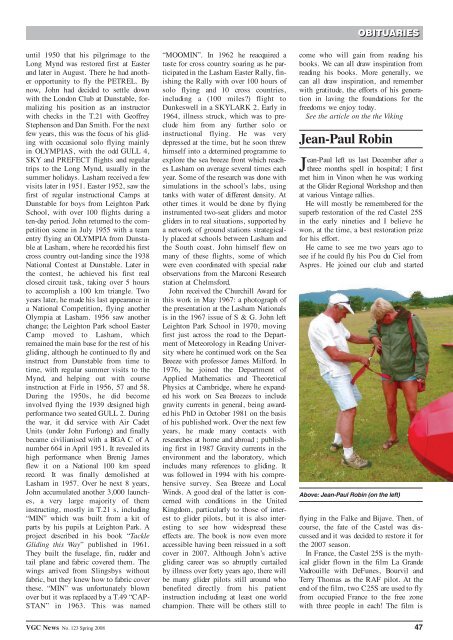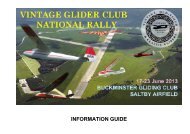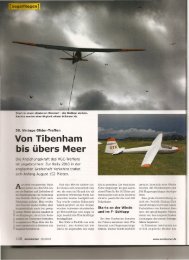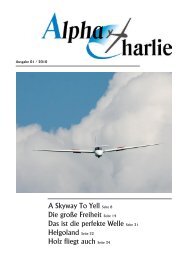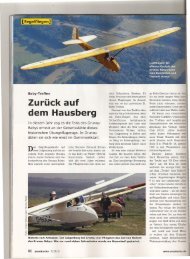Download - Vintage Glider Club
Download - Vintage Glider Club
Download - Vintage Glider Club
You also want an ePaper? Increase the reach of your titles
YUMPU automatically turns print PDFs into web optimized ePapers that Google loves.
until 1950 that his pilgrimage to the<br />
Long Mynd was restored first at Easter<br />
and later in August. There he had another<br />
opportunity to fly the PETREL. By<br />
now, John had decided to settle down<br />
with the London <strong>Club</strong> at Dunstable, formalizing<br />
his position as an instructor<br />
with checks in the T.21 with Geoffrey<br />
Stephenson and Dan Smith. For the next<br />
few years, this was the focus of his gliding<br />
with occasional solo flying mainly<br />
in OLYMPIAS, with the odd GULL 4,<br />
SKY and PREFECT flights and regular<br />
trips to the Long Mynd, usually in the<br />
summer holidays. Lasham received a few<br />
visits later in 1951. Easter 1952, saw the<br />
first of regular instructional Camps at<br />
Dunstable for boys from Leighton Park<br />
School, with over 100 flights during a<br />
ten-day period. John returned to the competition<br />
scene in July 1955 with a team<br />
entry flying an OLYMPIA from Dunstable<br />
at Lasham, where he recorded his first<br />
cross country out-landing since the 1938<br />
National Contest at Dunstable. Later in<br />
the contest, he achieved his first real<br />
closed circuit task, taking over 5 hours<br />
to accomplish a 100 km triangle. Two<br />
years later, he made his last appearance in<br />
a National Competition, flying another<br />
Olympia at Lasham. 1956 saw another<br />
change; the Leighton Park school Easter<br />
Camp moved to Lasham, which<br />
remained the main base for the rest of his<br />
gliding, although he continued to fly and<br />
instruct from Dunstable from time to<br />
time, with regular summer visits to the<br />
Mynd, and helping out with course<br />
instruction at Firle in 1956, 57 and 58.<br />
During the 1950s, he did become<br />
involved flying the 1939 designed high<br />
performance two seated GULL 2. During<br />
the war, it did service with Air Cadet<br />
Units (under John Furlong) and finally<br />
became civilianised with a BGA C of A<br />
number 664 in April 1951. It revealed its<br />
high performance when Brenig James<br />
flew it on a National 100 km speed<br />
record. It was finally demolished at<br />
Lasham in 1957. Over he next 8 years,<br />
John accumulated another 3,000 launches,<br />
a very large majority of them<br />
instructing, mostly in T.21 s, including<br />
“MIN” which was built from a kit of<br />
parts by his pupils at Leighton Park. A<br />
project described in his book “Tackle<br />
Gliding this Way” published in 1961.<br />
They built the fuselage, fin, rudder and<br />
tail plane and fabric covered them. The<br />
wings arrived from Slingsbys without<br />
fabric, but they knew how to fabric cover<br />
these. “MIN” was unfortunately blown<br />
over but it was replaced by a T.49 “CAP-<br />
STAN” in 1963. This was named<br />
“MOOMIN”. In 1962 he reacquired a<br />
taste for cross country soaring as he participated<br />
in the Lasham Easter Rally, finishing<br />
the Rally with over 100 hours of<br />
solo flying and 10 cross countries,<br />
including a (100 miles?) flight to<br />
Dunkeswell in a SKYLARK 2. Early in<br />
1964, illness struck, which was to preclude<br />
him from any further solo or<br />
instructional flying. He was very<br />
depressed at the time, but he soon threw<br />
himself into a determined programme to<br />
explore the sea breeze front which reaches<br />
Lasham on average several times each<br />
year. Some of the research was done with<br />
simulations in the school’s labs, using<br />
tanks with water of different density. At<br />
other times it would be done by flying<br />
instrumented two-seat gliders and motor<br />
gliders in to real situations, supported by<br />
a network of ground stations strategically<br />
placed at schools between Lasham and<br />
the South coast. John himself flew on<br />
many of these flights, some of which<br />
were even coordinated with special radar<br />
observations from the Marconi Research<br />
station at Chelmsford.<br />
John received the Churchill Award for<br />
this work in May 1967: a photograph of<br />
the presentation at the Lasham Nationals<br />
is in the 1967 issue of S & G. John left<br />
Leighton Park School in 1970, moving<br />
first just across the road to the Department<br />
of Meteorology in Reading University<br />
where he continued work on the Sea<br />
Breeze with professor James Milford. In<br />
1976, he joined the Department of<br />
Applied Mathematics and Theoretical<br />
Physics at Cambridge, where he expanded<br />
his work on Sea Breezes to include<br />
gravity currents in general, being awarded<br />
his PhD in October 1981 on the basis<br />
of his published work. Over the next few<br />
years, he made many contacts with<br />
researches at home and abroad ; publishing<br />
first in 1987 Gravity currents in the<br />
environment and the laboratory, which<br />
includes many references to gliding. It<br />
was followed in 1994 with his comprehensive<br />
survey. Sea Breeze and Local<br />
Winds. A good deal of the latter is concerned<br />
with conditions in the United<br />
Kingdom, particularly to those of interest<br />
to glider pilots, but it is also interesting<br />
to see how widespread these<br />
effects are. The book is now even more<br />
accessible having been reissued in a soft<br />
cover in 2007. Although John’s active<br />
gliding career was so abruptly curtailed<br />
by illness over forty years ago, there will<br />
be many glider pilots still around who<br />
benefited directly from his patient<br />
instruction including at least one world<br />
champion. There will be others still to<br />
OBITUARIES<br />
come who will gain from reading his<br />
books. We can all draw inspiration from<br />
reading his books. More generally, we<br />
can all draw inspiration, and remember<br />
with gratitude, the efforts of his generation<br />
in laving the foundations for the<br />
freedoms we enjoy today.<br />
See the article on the the Viking<br />
Jean-Paul Robin<br />
Jean-Paul left us last December after a<br />
three months spell in hospital; I first<br />
met him in Vinon when he was working<br />
at the <strong>Glider</strong> Regional Workshop and then<br />
at various <strong>Vintage</strong> rallies.<br />
He will mostly be remembered for the<br />
superb restoration of the red Castel 25S<br />
in the early nineties and I believe he<br />
won, at the time, a best restoration prize<br />
for his effort.<br />
He came to see me two years ago to<br />
see if he could fly his Pou du Ciel from<br />
Aspres. He joined our club and started<br />
Above: Jean-Paul Robin (on the left)<br />
flying in the Falke and Bijave. Then, of<br />
course, the fate of the Castel was discussed<br />
and it was decided to restore it for<br />
the 2007 season.<br />
In France, the Castel 25S is the mythical<br />
glider flown in the film La Grande<br />
Vadrouille with DeFunes, Bourvil and<br />
Terry Thomas as the RAF pilot. At the<br />
end of the film, two C25S are used to fly<br />
from occupied France to the free zone<br />
with three people in each! The film is<br />
VGC News No. 123 Spring 2008 47


